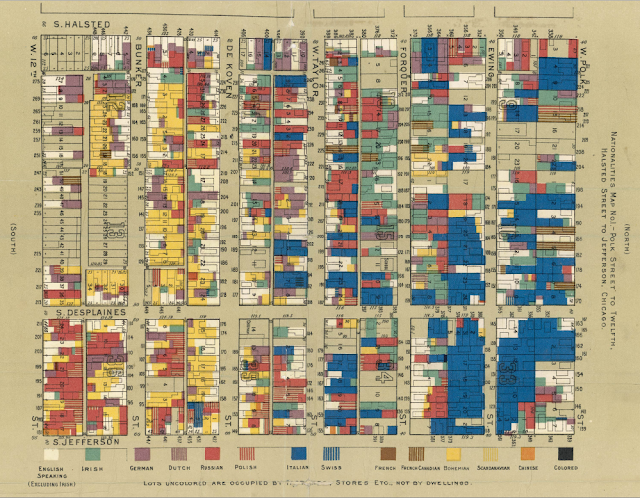 |
| https://mapatranslation.com/37-maps-that-explain-how-america-is-a-nation-of-immigrants/ |
This exhaustive map includes 51 infographics (for each state plus Washington, DC). The right column of the infographic covers how many immigrants settled in the state each year; the left column shows their occupations. The top depicts the ethnic mix, color-coded by race: Teutonic, Keltic, Slavic, Iberic, Mongolic, and “all others." See "37 Maps That Explain How America Is A Nation Of Immigrants."A migration pattern is a historical reconstruction taken from records that map the most common routes taken by immigrants from one country to another or from one section of America to another.
As I help people with genealogical research, I commonly find that very few researchers are aware of the patterns of migration as they affect their ancestors. For example, when I find an ancestor who lived in Ohio or Indiana or Kentucky or any other place in America, one of the first questions I ask concerns the ancestor's origin. With few exceptions, genealogists are unaware of the concept of migration and have no idea about the pattern or origin of the settlers in the areas where their ancestors lived.
It is obvious that your ancestors did not just appear suddenly in any particular geographic area. Knowledge of migrations patterns is crucial in helping to identify elusive ancestors and in distinguishing between individuals with the same or similar names. For example, if you find an ancestor in Kentucky in the early 1800s: where did the family most probably originate? Migration patterns provide the most likely places of origin and help to prioritize research objectives.
Explaining the background and context of historical migration patterns in America is not a subject for a short article or a single blog post. Since the existence of a migration route is embedded in the historical context of the time, understanding any particular migration route involves a study of both the pertinent history and applicable geography. From a practical standpoint, it is a good idea to divide migration into pre- and post-industrial revolution time periods. As the United States became industrialized, travel became faster and more available. From a genealogical standpoint, the rules concerning the distance anyone could have traveled to get married or bear a child, expanded with the overall availability of transportation and likewise naturally contract as we go back in time. Even after the Industrial Revolution, notwithstanding the increased availability of transportation from one area to another, it is still common to find a family or families living in the same geographic area for generations.
Migration patterns are also closely related to settlement patterns. However, settlement patterns are more prone to dependency on the availability of land, employment in any given area, and other economic considerations. In America, settlement patterns also often reflect the ultimate origin of the immigrants. For example, German-speaking immigrants tended to settle near others who spoke the same language. On the other hand, early colonial era migration patterns reflect the geography and topology of the land more than any other consideration.
In addition to the migration patterns, that tend to be summaries of historical population movements, individual concerns played a major role in determining the movement of individuals within the general population. For example, primogeniture or the pattern of inheritance where the oldest son received the property from his father, also created an incentive for younger sons to immigrate to another part of the continent. These movements or migrations across America and in other countries were not random. Individuals may be unpredictable, but masses of people follow a pattern.
In this series, I will be discussing the major population movements and the patterns of migration that affect genealogical research. Stay tuned for future posts.




No comments:
Post a Comment